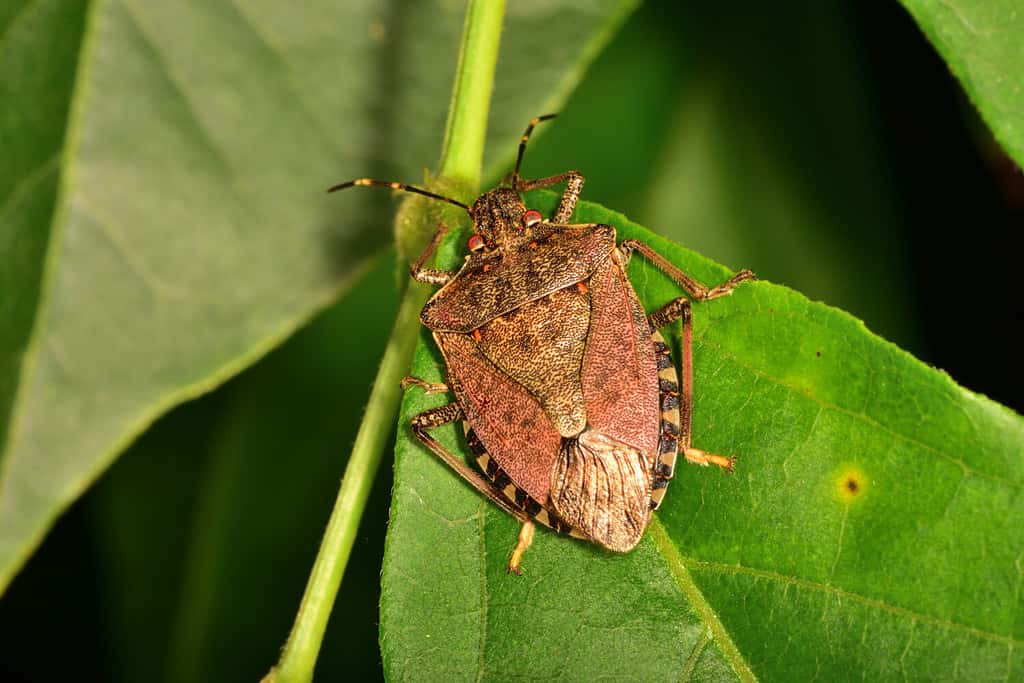Discover 9 Smells Stink Bugs Absolutely Hate and Keep Them Out of Your House
There are more bugs on the planet than any other animal, so it is no wonder that they occasionally wander into our homes. Even if you keep everything pretty clean and put up food, bugs may still find their way into your home for one reason or another.
Luckily, there are many ways to keep stink bugs out of your home. One of these is through the different scents that you utilize. There are many smells stink bugs hate, and using several different ones helps eliminate these bugs from the area.
Types of Stink Bugs

©Davide Bonora/Shutterstock.com
There are tons of stink bugs worldwide – with over 4,700 species worldwide. There are over 200 species in North America alone. Stink bugs are classified in the order Hemiptera, family Pentatomidae, and are commonly known as shield bugs.
Stink bugs are best known for their flattened, shield-shaped bodies and ability to produce a foul odor when disturbed. They can come in various patterns and colors depending on their species.
Some species are very brightly colored, while others are camouflaged.
For the most part, there are two main types of stink bugs – herbivorous and predatory. As the name suggests, herbivorous stink bugs feed on plants, while predatory stink bugs eat other insects. All species belong to one of these two categories.
You can find stink bugs just about everywhere. With so many species, there is bound to be one adapted to just about any habitat and climate. Many stink bugs are migratory, so you may see certain species more in certain areas during certain seasons.
Here are some common examples of stink bugs:
- Brown marmorated stink bug: This is a non-native stink bug that is widespread throughout North America. They’re considered a serious agricultural pest and can invade many homes.
- Brown stink bug: This species is very common and feeds on a variety of plants, including some agricultural species.
- Green stink bug: This stink bug is similar to the previous one but is green instead of brown.
- Two-spotted stink bug: This predatory species feeds on other insects, including aphids. Therefore, it’s often welcomed in gardens.
- Spined soldier bug: This is a predatory stink bug that feeds on many different insects, including caterpillars, beetles, and other stink bug species.
- Anchor bug: Despite the name, this is a species of stink bug. It is predatory and feeds on aphids, leafhoppers, and mosquitoes. Therefore, it is considered to be a good species to have around.
How to Get Rid of Stink Bugs
If you have stink bugs roaming around your home, there are several ways to get rid of them. For those that you can visibly see, consider vacuuming them up. They are slow insects, so chasing them with a vacuum isn’t that challenging. You can also use an insecticidal soap, which is a safe and effective method. Be sure to follow the directions on the label.
Stink bugs are typically attracted to a specific kind of plant. Therefore, you should remove all of these plants from your home. This step should help keep stink bugs from returning.
Consider sealing up any cracks or openings into your home, too. Stink bugs are very small and can enter through extremely small spaces.
Of course, you can also use certain plants and smells to help keep stink bugs away.
Smells Stink Bugs Hate

©Sergio Rojo/Shutterstock.com
1. Neem Oil
Neem oil is a natural, vegetable-based oil extract that comes from the neem tree (as you might guess from the name). It has a very strong odor, even for humans, and it is exceptionally bitter.
This oil is well known for its insect-repealing properties, and it is often utilized as a natural pesticide in gardens. Bugs won’t want to cross over it, so it works well near the openings of your homes.
2. Garlic
Garlic has a very strong, distinctive smell. It is also toxic to most animals, including bugs. Therefore, many species have learned to avoid it. Despite its toxicity to other species, it’s commonly used in culinary dishes. So, you may have some lying around your house.
Garlic is a great plant to add to your garden or around your home to deter stink bugs. You can also make your own garlic spray by crushing garlic cloves and mixing them with water. This natural repellent is completely safe but very effective.
3. Mint
This fragrant herb is known for its cool aroma and is well-loved by many people. However, bugs do not like it. You can plant it around your home or add a few potted plants inside to help deter stink bugs (and other bugs) from the area.
Spearmint and peppermint work best for this purpose, as they are the least liked by insects.
4. Lavender
Lavender is a very fragrant herb that is (once again) loved by many people. However, many bugs dislike it, especially when the flowers are in full bloom. It’s a pretty and sweet flower you can plant around your home or in pots on the inside.
Lavender oil also works in this way. You can make your own spray using watered-down essential oils or purchase lavender oil for a diffuser. Lavender is also an unpleasant scent for many pets.
5. Cinnamon
Cinnamon is a spice derived from the bark of trees in the Cinnamomum genus. It has a warm, sweet, and spicy fragrance. While people use cinnamon for all sorts of things, it’s disliked by most other animals.
Sprinkle cinnamon around the entry point of your home, or even consider hanging whole cinnamon sticks. You can also use cinnamon essential oil to imbue your home with this smell.
6. Citrus

©PradaBrown/Shutterstock.com
Citrus fruits, such as oranges, lemons, and grapefruits, have a zesty and tangy scent that comes from their peel and juices. Once again, this scent is liked by humans but disliked by practically every other animal.
You can use citrus-scented cleaners or sprays around the areas where stink bugs are common. You can also hang actual citrus peels, as this often works to repeal bugs.
7. Eucalyptus
This tall, evergreen tree is known for its very smelly leaves. Many humans like the smell, though some do not. You’ll also find many cleaners and detergents using this scent, which is thought to have a “fresh” smell.
That said, stink bugs do not like it. You can use the plant’s oil to effectively keep stink bugs away. You can also use sachets of the leaves hung near their entry points.
8. Onion
Onions (Allium cepa) are pungent, bulbous vegetables with a strong, sulfurous odor that can make people tear up when sliced. They’re a key to many culinary dishes, largely due to their aromatic taste and odor.
While humans love onions (usually), other animals, including stink bugs, do not. Therefore, you can effectively spray onion-scented water or even plant onions to deter stink bugs. These are some of the more intensely-smelling options, so they tend to work the best.
9. Peppermint Oil
Peppermint oil is derived from the peppermint plant. It has a very strong, yummy odor that most people associate with winter. However, stink bugs do not like it.
Mixing peppermint oil with water and spraying it around your home can help keep stink bugs and insects out.
Summary of 9 Smells Stink Bugs Hate
| Number | Scent |
|---|---|
| 1 | Neem Oil |
| 2 | Garlic |
| 3 | Mint |
| 4 | Lavender |
| 5 | Cinnamon |
| 6 | Citrus |
| 7 | Eucalyptus |
| 8 | Onion |
| 9 | Peppermint Oil |









